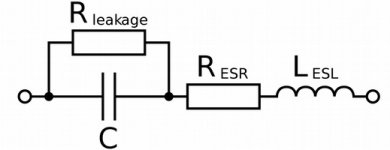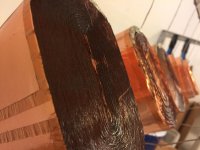Classicalfan, can you answer the question posed by Jakob2 in this thread? What kind of evidence do you consider as sufficient?
I can't find a post by Jakob2 in this thread. Looked through the entire list. Want to give me a post number and I'll try to find it.
But I'm going to bed very soon. It's late here. I may not respond until tomorrow.
Sorry, I don't understand why that should be, he started the thread, perhaps a mod can help please?
There’s a very good reason why you won’t find many such studies. The usually fall under the oversight and funding of a notoriously underfunded psychology department and measuring perception and specifically perception recognition is a complicated field, to make it worse performing randomized double blind studies is cumbersome/expensive. Here's an interesting discussion (typically from a tech institution) on the subject:
https://www.kth.se/social/files/57c...to the methods for perception measurement.pdf
I don't know if science would go so far as saying that everything that has been/is/could be measured could be perceived and vice versa. That would wreak havoc on f.i. medical science that still has a long way to measure stimuli like pain or provide measured data or 'proof' on such a common occurrence as migraines. There we can still only conclude they exist through anecdotal evidence and conjecture. I also think it's a fallacy to use the negative (lack of proof) as proof of the positive; this is akin to the "so you can't prove you did not beat your wife" type of argument.
Science does not know its debt to imagination.
Ralph Waldo Emerson
https://www.kth.se/social/files/57c...to the methods for perception measurement.pdf
I don't know if science would go so far as saying that everything that has been/is/could be measured could be perceived and vice versa. That would wreak havoc on f.i. medical science that still has a long way to measure stimuli like pain or provide measured data or 'proof' on such a common occurrence as migraines. There we can still only conclude they exist through anecdotal evidence and conjecture. I also think it's a fallacy to use the negative (lack of proof) as proof of the positive; this is akin to the "so you can't prove you did not beat your wife" type of argument.
Science does not know its debt to imagination.
Ralph Waldo Emerson
Last edited:
classicalfan is looking in this thread, not that one. The link works for me.perhaps a mod can help please?
In this article,
Interesting things stand out such as mechanical vibration inside the capacitor, which generates small voltages of different magnitude in the different brands / materials, of the capacitors.
It is assumed that these minimal voltage differences can be perceived by trained ears, and they are what give the sonic character.
That study was done by Clarity Cap. It is in the link.
Humble Homemade Hifi - Capacitor Test
DO CAPACITORS SOUND DIFFERENT?
In the past capacitors were just capacitors and sound quality was determined by the dialectric material with polypropylene considered by many as "the best" seeing as this type of capacitor had the lowest losses. But technology of the 21st century has brought us new measuring techniques and insights and there seems to be more to it. We can now measure things that were not possible a few years ago. In a nut-shell: microphony is the keyword - the mechanical resonance, a key feature of audio capacitors. This is a physical deformation of the capacitor plates which occurs as a result of the audio signal passing through the component, in some ways like how an electrostatic speaker works. This resonance is dependent on the size, shape, materials and manufacturing parameters of the capacitors. This effect has been known about for years as it plays a part in the impulse strength of capacitors. However, the effect has never been considered to be significant enough to affect a hi-fi system's audio reproduction due to the low energy involved. For more indepth information read the Clarity Cap white paper on mechanical resonances inside capacitors. Another interesting article was written by Martin Colloms back in 1985 in which he tested several capacitors on their sonic differences. Also look at the equivalent circuit diagram of a capacitor at the top of this page, this also explains a lot. A capacitor is more than just capacitance C!
Interesting things stand out such as mechanical vibration inside the capacitor, which generates small voltages of different magnitude in the different brands / materials, of the capacitors.
It is assumed that these minimal voltage differences can be perceived by trained ears, and they are what give the sonic character.
That study was done by Clarity Cap. It is in the link.
Humble Homemade Hifi - Capacitor Test
DO CAPACITORS SOUND DIFFERENT?
In the past capacitors were just capacitors and sound quality was determined by the dialectric material with polypropylene considered by many as "the best" seeing as this type of capacitor had the lowest losses. But technology of the 21st century has brought us new measuring techniques and insights and there seems to be more to it. We can now measure things that were not possible a few years ago. In a nut-shell: microphony is the keyword - the mechanical resonance, a key feature of audio capacitors. This is a physical deformation of the capacitor plates which occurs as a result of the audio signal passing through the component, in some ways like how an electrostatic speaker works. This resonance is dependent on the size, shape, materials and manufacturing parameters of the capacitors. This effect has been known about for years as it plays a part in the impulse strength of capacitors. However, the effect has never been considered to be significant enough to affect a hi-fi system's audio reproduction due to the low energy involved. For more indepth information read the Clarity Cap white paper on mechanical resonances inside capacitors. Another interesting article was written by Martin Colloms back in 1985 in which he tested several capacitors on their sonic differences. Also look at the equivalent circuit diagram of a capacitor at the top of this page, this also explains a lot. A capacitor is more than just capacitance C!
Attachments
yes its true electrolyics cap will reduce in capacitance over time. My 20 years old Audax speaker hv their capacitance reduced by 6% after 20 years. Film caps no change .
I wouldn,t bother to change unless the cap is more than 10 years use or if u got nothing better to do.
Its funny so many people chasing after things that won,t make much difference but forgot the elephant in room....the speaker driver. Do you know the rubber edge elasticity n spider change with temp ..winter vs summer . It is definitely more than 10%. The cone rigidity drops after a few years if its made of fibre . My audax aerogel speaker cone is a good example . Metal cones of course will last much longer..
It therefore much more relevant to upgrade your speakers drivers than cables ,inductors n capacitors
I wouldn,t bother to change unless the cap is more than 10 years use or if u got nothing better to do.
Its funny so many people chasing after things that won,t make much difference but forgot the elephant in room....the speaker driver. Do you know the rubber edge elasticity n spider change with temp ..winter vs summer . It is definitely more than 10%. The cone rigidity drops after a few years if its made of fibre . My audax aerogel speaker cone is a good example . Metal cones of course will last much longer..
It therefore much more relevant to upgrade your speakers drivers than cables ,inductors n capacitors
yes its true electrolyics cap will reduce in capacitance over time. My 20 years old Audax speaker hv their capacitance reduced by 6% after 20 years. Film caps no change .
I wouldn,t bother to change unless the cap is more than 10 years use or if u got nothing better to do.
Its funny so many people chasing after things that won,t make much difference but forgot the elephant in room....the speaker driver. Do you know the rubber edge elasticity n spider change with temp ..winter vs summer . It is definitely more than 10%. The cone rigidity drops after a few years if its made of fibre . My audax aerogel speaker cone is a good example . Metal cones of course will last much longer..
It therefore much more relevant to upgrade your speakers drivers than cables ,inductors n capacitors
But let's agree that it is not very practical.
And the problem is that when the speaker should already be replaced by "exhaustion" of the suspensions, that driver has probably been discontinued.
And assuming you get it, will it be unscathed in its T / S after the passage of time?
Foam suspensions don't just degrade from UV exposure, they "rot" in everyday jargon, they actually fall apart due to mechanical stress. They lowered the FS, but at what cost? I think it was an unfortunate breakthrough in speaker construction. A "conventional" vintage speaker surround, made of sticky fabric, will hold up well over time. Eminence and other PA speakers continue to use that system, and are subjected to much harsher treatment than in HI FI.
The solution here was to opt for synthetic rubber enveloping. These last for years with no disturbances that can be audible. The spiders are still accordions of fabric treated with resins and I do not think anything better is invented, the years do not affect them.
Last edited:
The elephant in the room is the room😉
Indeed.
Attachments
My 20 years old Audax speaker hv their capacitance reduced by 6% after 20 years.
😕
I am puzzled by this phrase, can you explain what "capacitance" of a speaker is and how is measured?
Do you put a capacimeter between its terminals, and then repeat the operation twenty years later ? 🙄
too bad that with all year here you dont have try some diy to taste with your hands , we have tested a lot of caps, do youknow what is distortions ?? the same on resistor ....I think you are mixing up threads. I started this one.
How many of the posters have series production loudspeaker testing experience, as in shop floor experience?
Design for speakers, sheet metal, cone, wiring, winding, coil formers?
The crossovers are designed bearing in mind the performance of the drivers within the box, and the production tolerances.
If in doubt, change the capacitors. And whatever else you feel like.
Use an app to see the response before and after, should be one out there, easy enough now with smart phones.
Then tell us how you fared, and what you gained and learned, instead of worrying about microphonic capacitors.
Most capacitors are now in plastic or metal housings.
Tantalum and solid alumina were microphonic, who uses them now?
Design for speakers, sheet metal, cone, wiring, winding, coil formers?
The crossovers are designed bearing in mind the performance of the drivers within the box, and the production tolerances.
If in doubt, change the capacitors. And whatever else you feel like.
Use an app to see the response before and after, should be one out there, easy enough now with smart phones.
Then tell us how you fared, and what you gained and learned, instead of worrying about microphonic capacitors.
Most capacitors are now in plastic or metal housings.
Tantalum and solid alumina were microphonic, who uses them now?
Last edited:
You are playing with the power supply to the speakers, which stay unchanged.
So for the most part, you are playing with makeup, rather than the singer.
Try coated cones, rebuilt speakers with different cone materials, different adhesives even.
That should be interesting.
So for the most part, you are playing with makeup, rather than the singer.
Try coated cones, rebuilt speakers with different cone materials, different adhesives even.
That should be interesting.
take a look how a caps are made of, you cannot thinks that a micron vaporized alu can work like this ones.....
Attachments
Last edited:
As I've already discussed I haven't tried to make any changes to the Piccolos and have no intention of doing so.
Did I mention the Piccolos? No. It was a general question. In general, have you ever, was my query. I did not mention altering the Piccolos, you did.
Wolf
No, I haven't. And frankly I don't see any reason to change the capacitors if you are totally satisfied with the performance of a speaker. Which is the case with my Piccolos.
I guess it's possible that I could have a speaker that I think needs tweaking. But not sure even in that case I would start with the crossover capacitors. Lots of variables to consider
I guess it's possible that I could have a speaker that I think needs tweaking. But not sure even in that case I would start with the crossover capacitors. Lots of variables to consider
classicalfan is looking in this thread, not that one. The link works for me.
Thanks. I think when someone demands proof they need to know what it is they are asking.
OK. I found the link and looked at it. It's a thread from 2018 that discusses essentially this same topic as here and is 93 pages long.
I obviously am not going to read through the entire thread, but did a cursory look at some of the posts. And there appear to be arguments on both sides of the issue.
So what exactly am I suppose to take away from this? I don't see anything different or new from what has been discussed here and in other recent threads on this topic.
I obviously am not going to read through the entire thread, but did a cursory look at some of the posts. And there appear to be arguments on both sides of the issue.
So what exactly am I suppose to take away from this? I don't see anything different or new from what has been discussed here and in other recent threads on this topic.
- Status
- Not open for further replies.
- Home
- Loudspeakers
- Multi-Way
- Should You Change Crossover Capacitors – The Great Debate


